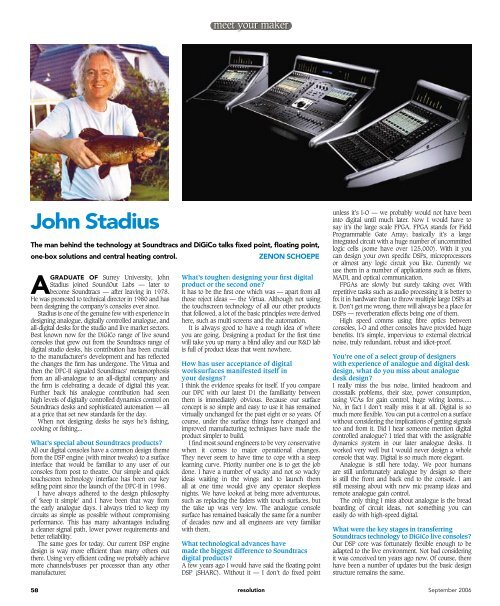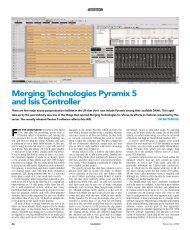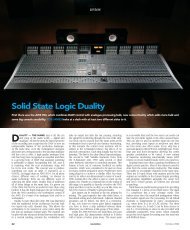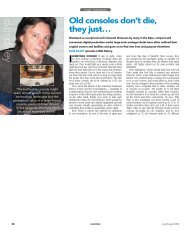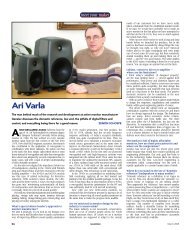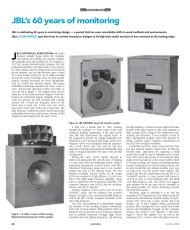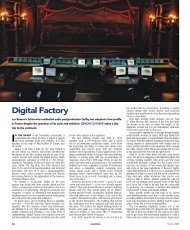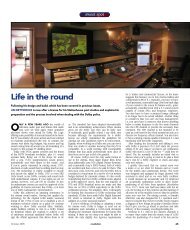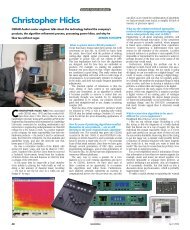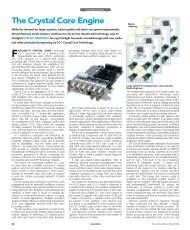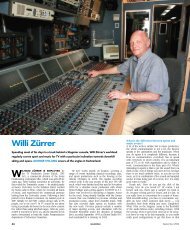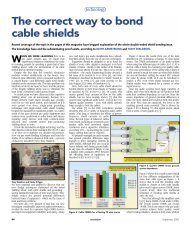John Stadius -- Digico/Soundtracs - Resolution
John Stadius -- Digico/Soundtracs - Resolution
John Stadius -- Digico/Soundtracs - Resolution
Create successful ePaper yourself
Turn your PDF publications into a flip-book with our unique Google optimized e-Paper software.
meet your maker<br />
<strong>John</strong> <strong>Stadius</strong><br />
The man behind the technology at <strong>Soundtracs</strong> and DiGiCo talks fixed point, floating point,<br />
one-box solutions and central heating control.<br />
A<br />
GRADUATE OF Surrey University, <strong>John</strong><br />
<strong>Stadius</strong> joined SoundOut Labs — later to<br />
become <strong>Soundtracs</strong> — after leaving in 1978.<br />
He was promoted to technical director in 1980 and has<br />
been designing the company’s consoles ever since.<br />
<strong>Stadius</strong> is one of the genuine few with experience in<br />
designing analogue, digitally controlled analogue, and<br />
all-digital desks for the studio and live market sectors.<br />
Best known now for the DiGiCo range of live sound<br />
consoles that grew out from the <strong>Soundtracs</strong> range of<br />
digital studio desks, his contribution has been crucial<br />
to the manufacturer’s development and has reflected<br />
the changes the firm has undergone. The Virtua and<br />
then the DPC-II signaled <strong>Soundtracs</strong>’ metamorphosis<br />
from an all-analogue to an all-digital company and<br />
the firm is celebrating a decade of digital this year.<br />
Further back his analogue contribution had seen<br />
high levels of digitally controlled dynamics control on<br />
<strong>Soundtracs</strong> desks and sophisticated automation — all<br />
at a price that set new standards for the day.<br />
When not designing desks he says he’s fishing,<br />
cooking or fishing...<br />
What’s special about <strong>Soundtracs</strong> products?<br />
All our digital consoles have a common design theme<br />
from the DSP engine (with minor tweaks) to a surface<br />
interface that would be familiar to any user of our<br />
consoles from post to theatre. Our simple and quick<br />
touchscreen technology interface has been our key<br />
selling point since the launch of the DPC-II in 1998.<br />
I have always adhered to the design philosophy<br />
of ‘keep it simple’ and I have been that way from<br />
the early analogue days. I always tried to keep my<br />
circuits as simple as possible without compromising<br />
performance. This has many advantages including<br />
a cleaner signal path, lower power requirements and<br />
better reliability.<br />
The same goes for today. Our current DSP engine<br />
design is way more efficient than many others out<br />
there. Using very efficient coding we probably achieve<br />
more channels/buses per processor than any other<br />
manufacturer.<br />
ZENON SCHOEPE<br />
What’s tougher: designing your first digital<br />
product or the second one?<br />
It has to be the first one which was — apart from all<br />
those reject ideas — the Virtua. Although not using<br />
the touchscreen technology of all our other products<br />
that followed, a lot of the basic principles were derived<br />
here, such as multi screens and the automation.<br />
It is always good to have a rough idea of where<br />
you are going. Designing a product for the first time<br />
will take you up many a blind alley and our R&D lab<br />
is full of product ideas that went nowhere.<br />
How has user acceptance of digital<br />
worksurfaces manifested itself in<br />
your designs?<br />
I think the evidence speaks for itself. If you compare<br />
our DPC with our latest D1 the familiarity between<br />
them is immediately obvious. Because our surface<br />
concept is so simple and easy to use it has remained<br />
virtually unchanged for the past eight or so years. Of<br />
course, under the surface things have changed and<br />
improved manufacturing techniques have made the<br />
product simpler to build.<br />
I find most sound engineers to be very conservative<br />
when it comes to major operational changes.<br />
They never seem to have time to cope with a steep<br />
learning curve. Priority number one is to get the job<br />
done. I have a number of wacky and not so wacky<br />
ideas waiting in the wings and to launch them<br />
all at one time would give any operator sleepless<br />
nights. We have looked at being more adventurous,<br />
such as replacing the faders with touch surfaces, but<br />
the take up was very low. The analogue console<br />
surface has remained basically the same for a number<br />
of decades now and all engineers are very familiar<br />
with them.<br />
What technological advances have<br />
made the biggest difference to <strong>Soundtracs</strong><br />
digital products?<br />
A few years ago I would have said the floating point<br />
DSP (SHARC). Without it — I don’t do fixed point<br />
unless it’s I-O — we probably would not have been<br />
into digital until much later. Now I would have to<br />
say it’s the large scale FPGA. FPGA stands for Field<br />
Programmable Gate Array; basically it’s a large<br />
integrated circuit with a huge number of uncommitted<br />
logic cells (some have over 125,000). With it you<br />
can design your own specific DSPs, microprocessors<br />
or almost any logic circuit you like. Currently we<br />
use them in a number of applications such as filters,<br />
MADI, and optical communication.<br />
FPGAs are slowly but surely taking over. With<br />
repetitive tasks such as audio processing it is better to<br />
fix it in hardware than to throw multiple large DSPs at<br />
it. Don’t get me wrong, there will always be a place for<br />
DSPs — reverberation effects being one of them.<br />
High speed comms using fibre optics between<br />
consoles, I-O and other consoles have provided huge<br />
benefits. It’s simple, impervious to external electrical<br />
noise, truly redundant, robust and idiot-proof.<br />
You’re one of a select group of designers<br />
with experience of analogue and digital desk<br />
design, what do you miss about analogue<br />
desk design?<br />
I really miss the bus noise, limited headroom and<br />
crosstalk problems, their size, power consumption,<br />
using VCAs for gain control, huge wiring looms.....<br />
No, in fact I don’t really miss it at all. Digital is so<br />
much more flexible. You can put a control on a surface<br />
without considering the implications of getting signals<br />
too and from it. Did I hear someone mention digital<br />
controlled analogue? I tried that with the assignable<br />
dynamics system in our later analogue desks. It<br />
worked very well but I would never design a whole<br />
console that way. Digital is so much more elegant.<br />
Analogue is still here today. We poor humans<br />
are still unfortunately analogue by design so there<br />
is still the front and back end to the console. I am<br />
still messing about with new mic preamp ideas and<br />
remote analogue gain control.<br />
The only thing I miss about analogue is the bread<br />
boarding of circuit ideas, not something you can<br />
easily do with high-speed digital.<br />
What were the key stages in transferring<br />
<strong>Soundtracs</strong> technology to DiGiCo live consoles?<br />
Our DSP core was fortunately flexible enough to be<br />
adapted to the live environment. Not bad considering<br />
it was conceived ten years ago now. Of course, there<br />
have been a number of updates but the basic design<br />
structure remains the same.<br />
58 resolution September 2006
meet your maker<br />
Our worksurface philosophy also transferred to<br />
the live domain very well, requiring only a few<br />
additional features such as snapshots, matrix and<br />
output processing channels.<br />
MADI was not the ideal medium for transferring<br />
large numbers of channels over 100 meters (front of<br />
house to stage) and I was not going to put the whole<br />
concept at risk by using CAT5 type cables. I cannot<br />
believe some manufacturers today are expecting users<br />
to rely on flimsy computer network cables for the main<br />
front of house snake. That is why we went to optical.<br />
Rather than reinventing the wheel we approached<br />
Optocore in Germany as they in my opinion had the<br />
best solution. It is capable of carrying 512 channels<br />
in a redundant loop. In conjunction with ‘battle field’<br />
Kevlar lined cables and expander beam connectors we<br />
now have the perfect solution.<br />
There’s also serviceability. I would be a fool if I<br />
said our products never go wrong. We live in the<br />
real world and the touring environment is a very<br />
harsh place for any piece of equipment. Taking this<br />
into account we re-engineered our live consoles to be<br />
very easily serviceable such that we can now swap a<br />
complete engine core in less than two minutes.<br />
How significant are the differences in<br />
expectation between studio and live engineers?<br />
Live engineers live in the fast lane and the theatre<br />
engineers appear to travel that bit faster. There is no<br />
going back for a retake in live, they have to get it<br />
right first time. Having said that both studio and live<br />
engineers want a console that is responsive and easy<br />
to use. Neither wants to stop and read the manual. I<br />
hate products where you have to constantly refer to<br />
a manual every time you want to use it. My central<br />
heating control box at home springs to mind. It’s my<br />
old philosophy again, keep it simple.<br />
From your standpoint, what differentiates<br />
the different brands of competing digital<br />
desk in the market?<br />
They all, more or less, do a similar job but it’s how they<br />
present themselves, i.e. the man-machine interface,<br />
that mainly differentiates the different brands.<br />
Currently nearly all digital consoles have a surface<br />
that is to a greater or lesser extent assignable. It’s<br />
the degree of assignability that differentiates the<br />
different products. Many products provide the<br />
controls for just a single channel accessed by a<br />
channel select key. While keeping the costs down it<br />
does not let a user control more than one channel<br />
at a time. The DiGiCo/<strong>Soundtracs</strong> approach is to<br />
60 resolution September 2006
meet your maker<br />
provide visual indication of what is happening on<br />
all faders on the console, i.e. EQ, Dynamics, gain,<br />
pan, etc, and have dedicated controls for each<br />
block of eight channels. This I believe is a good<br />
compromise.<br />
I mentioned briefly floating point verses fixed before.<br />
DiGiCo/<strong>Soundtracs</strong> consoles have always been based<br />
around floating point processors. Early DSPs were<br />
fixed point and like analogue systems they had a<br />
fixed dynamic range. Some console manufacturers still<br />
employ them. Normally 24 bits gives a dynamic range<br />
of up to 144dB. This sounds like a lot but when you<br />
are bringing in signals around line level you only have<br />
about 22dB of headroom — same as analogue. Signals<br />
arriving at any digital console (from A-D convertors,<br />
AES-EBU or MADI) are by their nature fixed point. It’s<br />
when you come to mix them that you start to run in<br />
to headroom problems. A floating point system enables<br />
you to increase this headroom by a fantastic amount,<br />
1000s of dBs. Now we have a system that is almost<br />
impossible to clip. Of course, when we return to the real<br />
world we have to convert back to fixed point but as<br />
long as we don’t clip the output by driving it too hard<br />
users can be happy in knowing that the integrity of the<br />
original signal is preserved.<br />
On the issue of the number of bits it is often assumed<br />
that 32-bit floating point is good enough. This is not the<br />
case. When it comes to low frequency signals we found<br />
we had to up the process to 40 bits to again preserve<br />
the integrity of the signal. If you listen carefully to a low<br />
filter on a 32-bit floating point product you will hear<br />
what I call a slight gritty sound.<br />
One other aspect I feel differentiates digital mixers is how<br />
manufacturers build them. Some are presented as a collection<br />
of boxes, worksurface, power supplies, racks of DSPs, I-O<br />
boxes, etc. Others provide a simple one-box solution.<br />
We have always been a one-box solution (apart<br />
from the I-O racks). Having separate worksurface,<br />
DSP and power supplies is not the way to go about<br />
designing a live desk. Engineers want to turn up, open<br />
the box, turn on and mix. For the studio engineer this<br />
is not so much of an issue.<br />
Having the I-O built into the product can also be<br />
a problem. The ideal solution is to do the conversion<br />
as close to the source as possible. Analogue signals,<br />
especially from sources such as microphones, are very<br />
sensitive to interference and degrade rapidly over long<br />
cable runs. Having all our I-O in remote racks again<br />
minimises this issue. The other advantage is the<br />
elimination of the expensive and very bulky multicore<br />
snake. Our 150-metre fibre optic drum capable of<br />
handling 512 channels weighs only 6kg.<br />
What products are you most proud<br />
of and what would you most like<br />
to build?<br />
From a cosmetic point of view I loved<br />
the DS3. The DSP engine and power<br />
supply were held in a single leg<br />
with the very thin profile worksurface<br />
on top. It was a challenging engineering<br />
project.<br />
As for one product I would like to build... most<br />
products these days have too many functions for<br />
too few controls. Digital cameras, MP3 players,<br />
mobile phones and my central heating control unit<br />
spring to mind. I always have to keep referring back<br />
to the manual. Is it me or am I getting old? So, I will<br />
start with a simple central heating control box. ■<br />
Quested_S8_<strong>Resolution</strong>_ad_5-05.qxd 4/5/05 2:13 pm Page 1<br />
Aspirational sound,<br />
inspirational price<br />
September 2006<br />
resolution<br />
61


